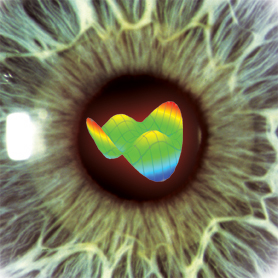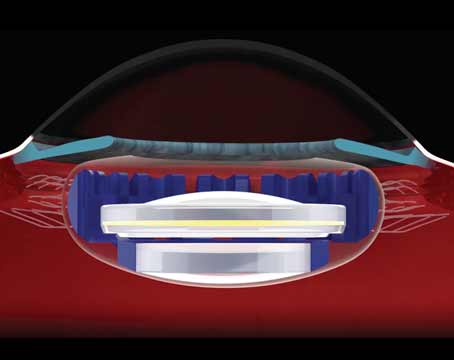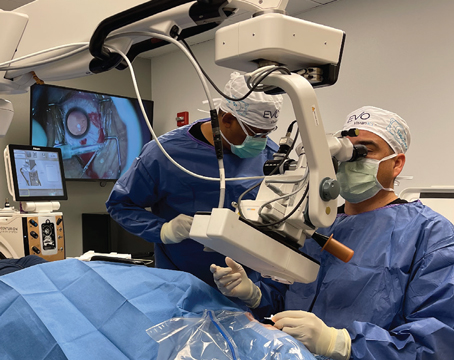The advent of customized laser vision correction platforms may enable the ophthalmologist to offer his patients a quality of vision that is more precise than ever before. But not all patients are good candidates for custom ablation under current FDA labeling, and others may balk at the increased expense. This article will review how refractive surgeons have smoothly introduced custom to their practice, talk to their patients about the procedure and have modified their marketing and pricing to pay for it.
Who's Doing Custom Procedures?
No longer does customized laser vision correction lie solely in the territory of an elite group of leading-edge surgeons who buzz through wavefront data and theoretical algorithms. In all American markets, and much of the world, anyone can hear and see advertising for the latest offering in refractive surgery and talk to others who have already had custom LVC done. "Ophthalmologists who have been doing LASIK for years see customized procedures as the evolution of laser vision correction, the next logical step in the progression of the technology and the improvement of outcomes," explains Heather Ready, director, global marketing, for Visx (Santa Clara, Calif.) She believes that any refractive surgeons who do not get involved with custom procedures are going to be at a disadvantage in the marketplace. "The surgeons who don't do custom are probably the doctors who do not own their own laser, but use an open-access center for their patients who want LASIK," she reasons.
 |
There also do not seem to be a number of ophthalmologists getting into LVC now just because the custom systems are available. "We haven't seen growth in the number of MDs who are involved in refractive surgery in quite some time, since the 'boom' of LASIK in the '90s," points out Holly Cross, global product manager, practice development, for Alcon Surgical (Fort Worth, Texas).
Why Do Custom?
"What's compelling about customized LVC is that we can offer patients a much higher chance that they are going to see 20/20 or better uncorrected," offers Mark Speaker, MD, PhD, of Laser & Cornea Surgery Associates PC in New York City, and a user of Alcon's LADARVision platform. "It's an advancement that is going to do everything that we need it to — give excellent uncorrected vision and minimize night vision problems."
For Mitchell Jackson, MD, who uses Bausch & Lomb's Zyoptix system for his patients in the Chicago area, his measure of satisfaction with customized LVC is an enhancement rate of zero since moving to Zyoptix more than seven months ago. "That alone indicates better outcomes," he says, "and means a cost savings for the doctor and happiness for the patient." Dr. Jackson is not alone in his enthusiasm for the personalized procedures. According to Alcon's Ms. Cross, "What we are seeing is a slow but sure infusion of excitement about laser vision correction back into the marketplace. Surgeons are excited to be able to tell their patients, 'You may be able to see better than you ever have before.' "
Who Gets Wavefront?
Like the other surgeons interviewed for this article, Brian Will, MD, of Will Vision & Laser Centers in Oregon and Vancouver, B.C., requires that wavefront measurements be taken on all patients who present for laser vision correction. But unlike the majority, who place the responsibility in the hands of a well-trained, experienced technician, Dr. Will, a CustomVue user, prefers to have the wavefront done by physicians only. "Our decision early on was that the wavefront is probably the most critical measurement we are going to do on a patient and that only the doctors here would do it. I think that's important from a medical-legal perspective and a quality-control perspective," he explains.
The practice of doing wavefront on everyone is a common one, agrees Warren Luster, director of practice management, Bausch & Lomb. "Many of our practices are making wavefront diagnostics a critical component of patient assessment and treatment. It's becoming the standard of care," he reports.
Integration into Daily Practice
For physicians who were using a wavefront scanner before the approval of the combined wavefront/laser platforms, the integration of custom laser technology has not been difficult for their practices to accomplish. Brigette Ellis, clinical research director at Durrie Vision PA in Overland Park, Kan., acknowledges that doing the wavefront was more work initially. "Anytime you introduce something new into your work system there is going to be a learning curve," she explains. She notes that Durrie Vision regularly uses the Zyoptix platform and LADARVision, and that all staff is cross-trained on both systems. This also took time, but has paid off in surgery-day efficiency.
David Shapiro, MD, whose practice has three locations in California's Central Coast, agrees adjustments must be made, but they can be done easily. "You can't just start custom LVC in your practice and expect the same pace with your patient flow," he says. "Clearly, it takes time to get accurate measurements, and you have to dedicate more chair time to the education of patients."
In Richard Blue, MD's, practice in Athens, Ga., that all-important staff buy-in equals delivery of a single, consistent message to patients. "The explanations of what wavefront technology means and its applications in refractive surgery were all well-covered in the training provided by Bausch & Lomb," he says. "But for creating our message about how this is to be presented to patients, I took the lead on that, with some of the senior staff." He says they held retreats and a few after-work seminars to present the custom LVC information to everyone.
Conventional or Custom?
The ability for everyone in a practice to understand the advantages to and limitations of customized LVC is important, because there are patients for whom a conventional LASIK treatment is the better choice. The availability of personalized procedures may drive traffic into a practice, but some potential patients may be disappointed if they are told they are not eligible for custom LVC. Chicago's Dr. Jackson handles this situation by doing the wavefront and using it to show a patient why he will do better with one procedure over the other.
Dr. Blue hopes to avoid the conversation about conventional vs. custom altogether. "We do the wavefront maps on everyone, and tell them that we will use that wavefront technology to its fullest extent. For some patients, that fullest extent is a custom treatment with Zyoptix," he explains. "For others, even though we can't use their wavefront data for a custom procedure, it has taught us a lot about their vision." What he wants to avoid, he says, is describing conventional LASIK as something less than ideal.
Patients referred to Karl Stonecipher, MD, in Greensboro, N.C., are often complex cases who are not sure what they need, let alone want, in a refractive procedure. Dr. Stonecipher uses an Alcon-Autonomous laser, the Visx CustomVue system or WaveLight's Allegretto wavefront-optimized platform to help these patients resolve their visual symptoms. "When patients are referred to me, they've been told that I have a lot of different instruments that their own physicians don't," he explains. "I'll measure them and talk about the discrepancies between their numbers and how we might do this with a conventional laser or a customized procedure—either the Allegretto or the CustomVue. I have an open discussion with them based on enhancement rates, etc., and we make decisions together."
Choice of Procedure
There's more to becoming a candidate for custom LVC than meeting the FDA-approved indications and intended uses labels. Dr. Stonecipher urges surgeons to "definitely always rely on your own measurements." When assessing someone for custom, he explains, "The manifest refraction that I get, my objective findings in clinic, need to match with the findings of the wavefront analyzer. If they don't, I am destined to error with my astigmatism correction."
Besides the labeling issues, there are other hard-and-fast medical issues that will rule out a custom procedure. "Pupil size has to be adequate, at least 5 mm," Dr. Shapiro reminds surgeons. "The person must also be physically able to perform the wavefront test. Some people accommodate too much during the wavefront, so we can't get a good reading. And without that good information, we can't do the custom procedure."
While most surgeons agree that custom LVC is inherently a better procedure for those patients who meet the requirements, Dr. Will opines, "If someone has a very low correction, it's hard to judge a difference between a conventional and a wavefront procedure, particularly if they don't have a lot of higher-order aberrations to start with." He says that custom offers real advantages with more complicated eyes with higher degrees of astigmatism and myopia, and that it's also better for patients who benefit from treatment of a larger optical zone, such as those who do a good deal of night driving.
Some surgeons and patients, while impressed with what wavefront can currently do, are putting off surgery until the next level of approvals for custom come through. Dr. Shapiro says that his hyperopes are choosing to wait for approval of custom for their vision. "I have a rare hyperope now for surgery in my practice," he shares. "There are some people who I will never be able to treat with custom, because their pupil size is too small, they accommodate too much, or they don't have enough cornea. They are more accepting of conventional LASIK. But those who can be a good candidate someday, when the labels expand for hyperopia and higher myopia, are choosing to wait for that."
Custom Enhancements
Alcon's Ms. Cross proposes that the best targets for a custom procedure are those who went through conventional LASIK, but now may see even better with custom. "They can come back and have their vision improved through enhancements with the custom system," she explains. "It gives a practice a reason to recontact people who are in their database."
Not all surgeons are so sure about this marketing approach. "I say, let's not wake up a sleeping baby," replies Dr. Stonecipher. "If a patient is doing well at 20/25, I'm not going to bring him back in just to try to make him happier. I could operate on him and make him 20/20 and unhappy for other reasons. I don't think we've reached the level yet with any platform to be able to promise patients improved outcomes over what they already have."
New York's Dr. Speaker agrees that reaching out to contented conventional-LASIK patients could be fraught with complications. "We do see a small but present subset of patients who had conventional surgery and have some night glare issues, etc. If we feel that a custom procedure will help them, we'll do it," he explains. "But I think promoting custom upgrades will only grow once we know more about how custom surgery applied to enhancements will turn out."
Marketing Rep or Technology?
It's common to hear both a surgeon's name mentioned in advertising for custom LVC, as well as the brand name of his technology. Dr. Blue has been doing refractive surgery in the Athens community for 13 years and relies on his reputation as his marketing message. "We market ourselves and the care of the patients that we give," he says. He does think it's smart to present to the community the fact that you have a new technology, but says the problem is that the effect is short-lived. "In a short time, everybody can have access to Brand X custom platform. Then, what do you have to differentiate you from the other guy down the street?" he asks.
In the Chicago area, Dr. Jackson reports he has found great value in associating himself with the Bausch & Lomb brand. "I received a lot of patient traffic via the B&L website following their nationwide promotion of Zyoptix," he says. He believes that the lay public has a positive brand name association with Bausch & Lomb from eyewear, contact lens solutions, etc., and he likes to tie his marketing messages to their wave of branding. "Of course, my name is out there too, but now I'm a surgeon using a well-known technology, and that has appeal."
Setting a Price
All of the practice management or marketing professionals at Alcon, Bausch & Lomb and Visx get questions from their custom LVC users about setting a price for the procedures. Some surgeons charge a single price for all LVC procedures, either custom or conventional. An equal number set one price for conventional and add on a flat fee or a percentage for a custom treatment. Others add in technology such as IntraLase to the total price. While none of the manufacturers, of course, tells a practice exactly what to charge, they all make recommendations on cost assessment and pricing models to follow.
Visx's business development team guides the doctor or the administrator through the thought process, explains Ms. Ready. She says, "We tell them to look at certain data points and then set a price. You want to understand what it's costing you to deliver this care and then charge a price that you feel is commensurate with your experience, your 'brand' in the community. Some practices are considered the premium provider and they should charge a premium price in that marketplace."
Durrie Vision in Kansas reexamined its whole pricing structure for refractive surgery once custom became regularly used, reports Refractive Surgery Director Bonnie Heck, RN, COA. "We went through a pretty extensive evaluation of what the additional costs would be, not only for the custom procedure itself, but considering additional staffing and testing costs too." In the end, they chose to charge one price for conventional procedures, and a higher price for custom. She notes that the concurrent addition of IntraLase on all platforms was also factored into pricing.
Bausch & Lomb's Mr. Luster acknowledges that price-setting is a market-specific decision, but advises Zyoptix practices to transition to a one-price model. "You introduce Zyoptix into your marketing mix and you use the advent of state-of-the-art technology to establish a marginally higher price point across the board," he says. He believes this is fair because all patients benefit from the additional information gleaned about their vision. "This model reintroduces much needed simplicity into your message and distances you from the 'asterisk' [about custom fees]."
"We quickly realized that tiered pricing was confusing to patients and that we would be much better served to charge a single price for all vision correction using the lasers," says Dr. Blue. "One price makes sense because the majority of the expense comes not from the treatment cards but from everything else: physician time, work of the technicians," he reasons.
Dr. Speaker knows that in New York, people do shop around. "They try to match the price to the value," he says. Even as a more expensive provider, his practice has a niche. "Our patients know that we provide the best equipment and the best staff for a great patient experience and great results. They know that if we find they are not good candidates for a procedure, we are going to tell them that."
In California, Dr. Shapiro reasons along the same lines. He believes the pendulum has swung away from people thinking of LASIK as a commodity and always the same. "Potential patients are beginning to understand that there really is stratification in how LASIK is performed and there are huge variations in quality out there. They are looking for which is best and seeing cost as less of an issue," he concludes.
Alcon's Ms. Cross believes that price-setting will become less of an issue as the labels for custom LVC expand. "When it's available for more patients," she says, "the discussion of whether you get custom or conventional and what is the price will go away."





